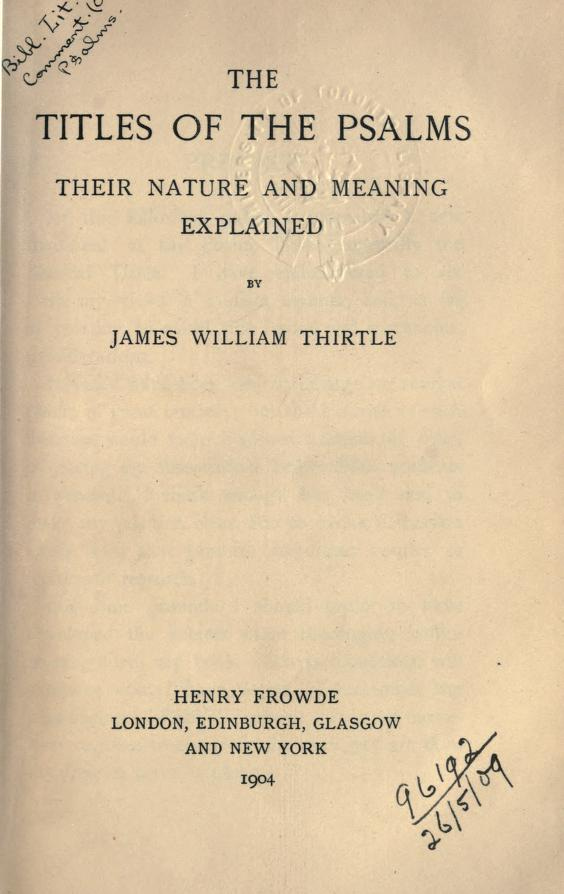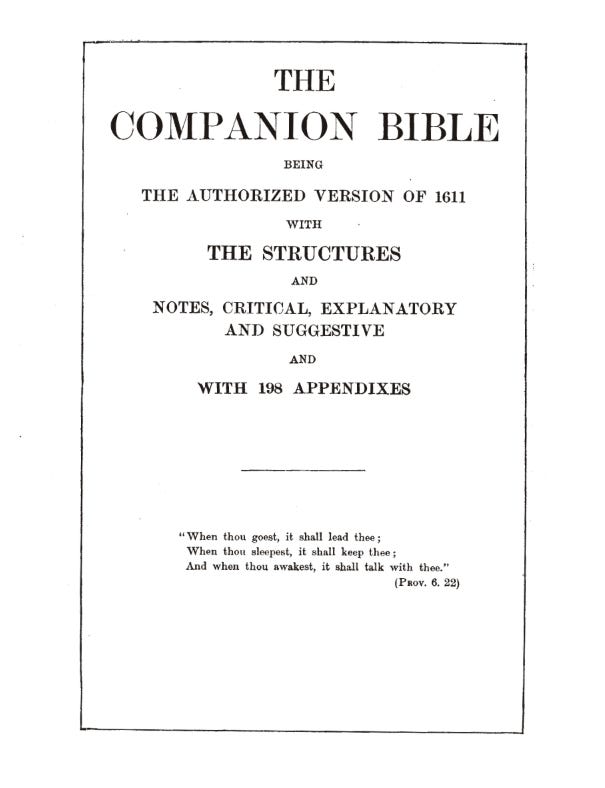Last year while preparing to preach on the Psalms, I was reading the ever insightful reformed Baptist Benajah Harvey Carroll’s An Interpretation of the English Bible. In his introduction he heartedly commended a number of books on the Psalms. One of these books was James William Thirtle’s work The Titles of the Psalms, of which Carroll said:
“This is the best on the subject and well worth a careful study.”
Psalm Titles are the textual notes affixed as headings over various Psalms. Not to be confused with the publishers headings which are not part of inspired Scripture, Psalm Titles are original to the text of Scripture, and Thirtle identified a categorization of these titles which solved all apparent discord among the various titles of the Psalms.
Thirtle recognized in Habakkuk 3:1–19 a “model psalm” which retained the proper arrangement of a Superscript (3:1a) and Postscript (3:19c).
The superscript consists of compositional matters: author, genre, historical setting, and the cultic or ceremonial purpose of the Psalm.
“A prayer of Habakkuk the prophet, according to Shigionoth.”
The postscript consists of performative matters: dedication to the Choirmaster, instrument(s), musical instruction.
“To the Choirmaster, with stringed instruments.”
This categorization of the Psalm titles fits every Psalm without exception. Even the notoriously confusing Psalm 55/56 concerning the “Dove’s of the Terebinths”, Psalm 87/88 regarding its seeming double authorship, Psalm 41/42 and the opening of Book 2 of the Psalms which has historically been assigned a dedication “to the Choirmaster.”
Below you will find links to Thirtle’s original work which includes his thesis, explanation of musical descriptions, and his arrangement of the Psalter Titles with commentary.
Another excellent resources is Outline of the Psalms by Bruce Waltke. I have not been able to find an online version of Waltke’s 1991 Superscript, Postscripts, or Both from Journal of Biblical Literature: 1104/4 (1991) 583–596, but his work is excellent, expanding on the same Biblical evidence as Thirtle with examples of superscripts and postscripts from other ancient sources and texts. A summary of his research is included in the introduction of his Outline of the Psalms.
Additional resources include web links that provide summary overviews of this perspective for quick perusal.
The Titles of the Psalms, Their Nature and Meaning Explained
James William Thirtle · 1904
Archive.org | Google Books (1st Edition, 2nd Edition) | Biblical eLearning
FOR THE CHIEF MUSICIAN
II. (I) THE KEY LOST
III. (2) THE KEY FOUND
IV. (3) SOME RESULTS OF MISCONSTRUCTION
THE CALENDAR IN THE PSALTER
V. (I) PSALMS FOR SPECIAL SEASONS
VI. (2) PSALMS FOR THE FEAST OF THE PASSOVER
VII. (3) PSALMS FOR A `SECOND PASSOVER
VIII. (4) PSALMS FOR THE FEAST OF TABERNACLES
DAVID IN THE PSALTER
IX. (I) THE POET-KING'S PLACE AND INFLUENCE
X. (2) ON THE DEATH OF GOLIATH
XI. (3) THE VICTORY OVER THE PHILISTINES
XII. (4) THE ARK BROUGHT TO ZION
VIII. (5) A NATIONAL ANTHEM
XIV. (6) CONFLICTS COMMEMORATED
XV. PSALMS FOR A SEASON OF HUMILIATION
XVI. PSALMS FOR SPECIAL CHOIRS
XVII. OTHER MUSICAL TITLES [rewritten in 2nd Edition]
XVIII. LITERARY AND HISTORICAL HEADINGS
XIX. SELAH-HIGGAION
XX. THE AGE OF THE PSALTER
XXI. OTHER THINGS THAT FOLLOW
XXII. CONCLUSION
APPENDIX
1. PSALM DIVISIONS AND CLASSES
2. THE AUTHORSHIP OF THE PSALMS
3. THE MUSICAL TITLES
4. SELAH
5. THE PSALM OF HABAKKUK
THE BOOK OF PSALMS (ACCORDING TO THE REVISED VERSION). WITH TITLES DISCRIMINATED AND BRIEFLY EXPLAINED
Psalm Titles: Inspiration and Thirtle’s Theory
Patrick Nickerson · 2017
“We might elaborate endlessly on the various ways in which the book of Psalms uniquely contributes to the edification of the saints, but that is not our precise purpose here. In what follows we will consider a particular aspect of the book of Psalms which has been sorely neglected since the inception of the Church; namely, the Psalm titles. When properly understood as to their nature and placement in the Psalter, the Psalm titles help to shed a measure of light on the passages to which they properly belong, subsequently increasing the benefit that we derive from our study of the Psalms.
Two points will be argued. First, in this post it will be argued that it is plausible that the Psalm titles are “theopneustos”; a part of the text of Scripture proper, and the very word of God. Second, in the next post arguments will be offered in favor of a theory propounded by James Thirtle in 1904.”
Psalms: Outline
Dr. Bruce Waltke
Introduction to Course and Psalms 1
Hermeneutics: Spiritual Approach
Historical Approach
Psalm 4
Hebrew Poetry and Psalm 23
Form Critical Approach with a Focus on Hymns
Psalm 100
Psalm 8
Grateful Songs of Praise and Psalm 92
Form Critical Approach with a Focus on Laments
Individual lament: Psalm 3
Individual lament: Psalm 22
Communal Laments: Psalms 90, 44
Songs of Trust: Psalms 91, 139
Liturgical Approach
Psalms 2, 110
Rhetorical Approach
Messianic Approach and Psalm 16
Wisdom Psalms and Psalms 19, 73
The Editorial Approach
Psalms post/superscripts
Kevin P. Edgecomb · 2007
“The superscripts or titles of the Psalms in the Old Testament have always been quite a puzzling thing. The differences in text between the Masoretic and Septuagintal traditions notwithstanding, the meanings of individual words and phrases continue to elude us, and suggestions for their meanings appear to still be as numerous as the commentators thereon. Aside from these issues of meaning, however, there is the simple issue of the arrangement of these “blurbs,” which some have proposed should actually be split into titles or superscripts, and postscripts or colophons.”
Book of Psalm: Introduction
International Standard Bible Encyclopedia Online
Titles in the Hebrew Text:
(1) Value of the Superscriptions.
(2) Thirtle’s Theory.
(3) Meaning of the Hebrew Titles.
(g) “Degrees”: see “Ascents” above.
(4) Testimony of the Titles as to Authorship.
(5) Titles Describing the Occasion of Writing.
The Psalms (Know Your Bible)
William Graham Scroggie · 1949
Archive.org (Volume 2)
William Graham Scroggie was trained at Spurgeon’s Pastor’s College and later appointed to the historic Metropolitan Tabernacle pulpit once occupied by the “Prince of Preachers” himself. Scroggie’s work The Psalms (Know Your Bible) arranges the Psalm inscriptions according to Thirtle's superscript-postscript model.
The Companion Bible
E. W. Bullinger (Editor) · Authorized Version · 1611/1886
Original Page Scans: The Complete Companion Bible | Psalms PDF
Edited and Compiled: The Complete Companion Bible | Psalms PDF
This is the earliest published Bible that formats the Psalms according to subscript and postscript. The preface states the following:
The Types Employed in the Text
The Book of Psalms, the Titles will be printed so as to present the super-scriptions and sub-scriptions as brought to light and demonstrated by Dr. J. W. Thirtle.
The Chief Musician Or, Studies in the Psalms, and Their Titles
E. W. Bullinger · 1908
E. W. Bulllinger was the senior colleague of James Thirtle. Bullinger endorsed Thirtles work in this 1908 expansion upon the study of Psalms and their titles.









